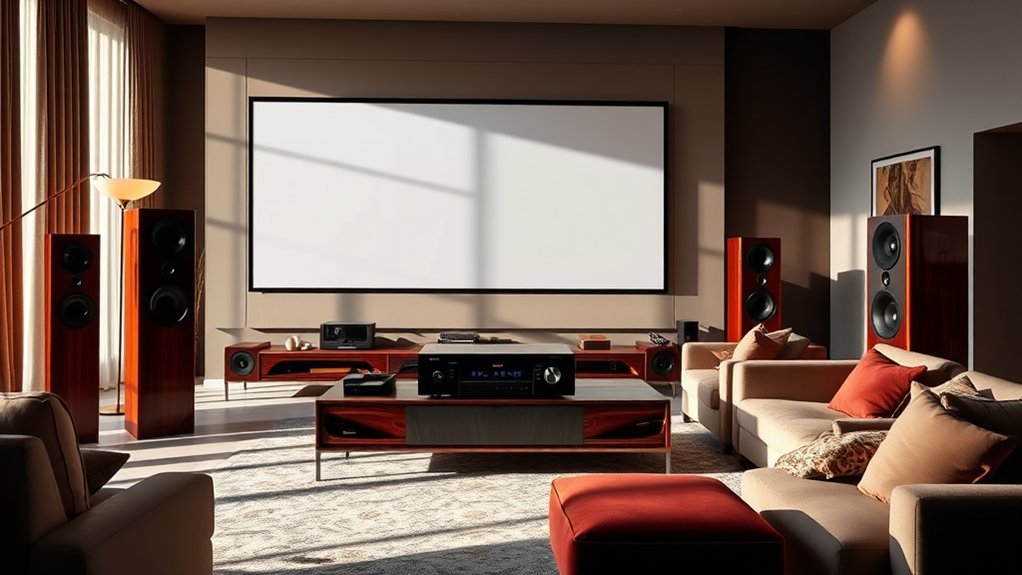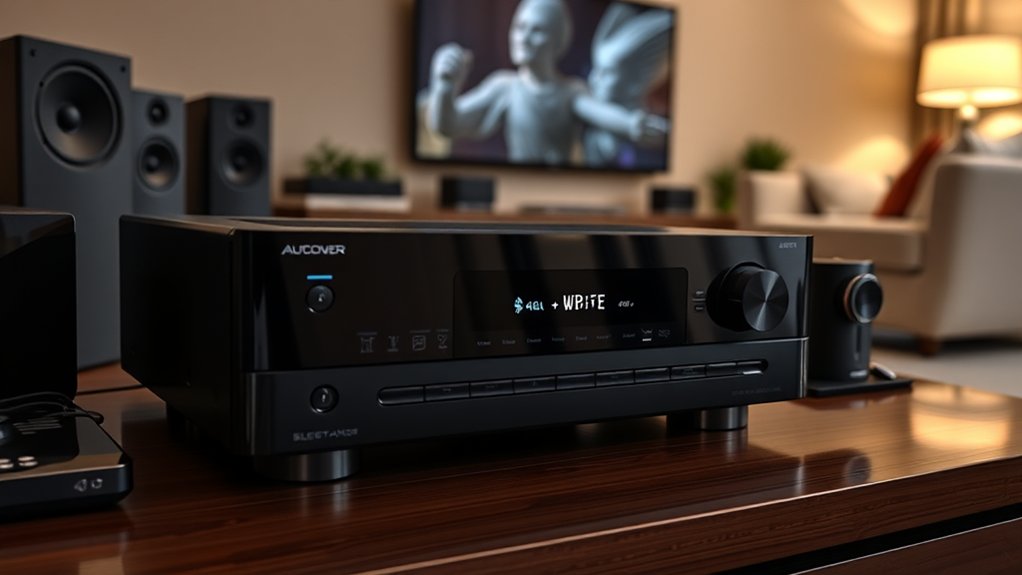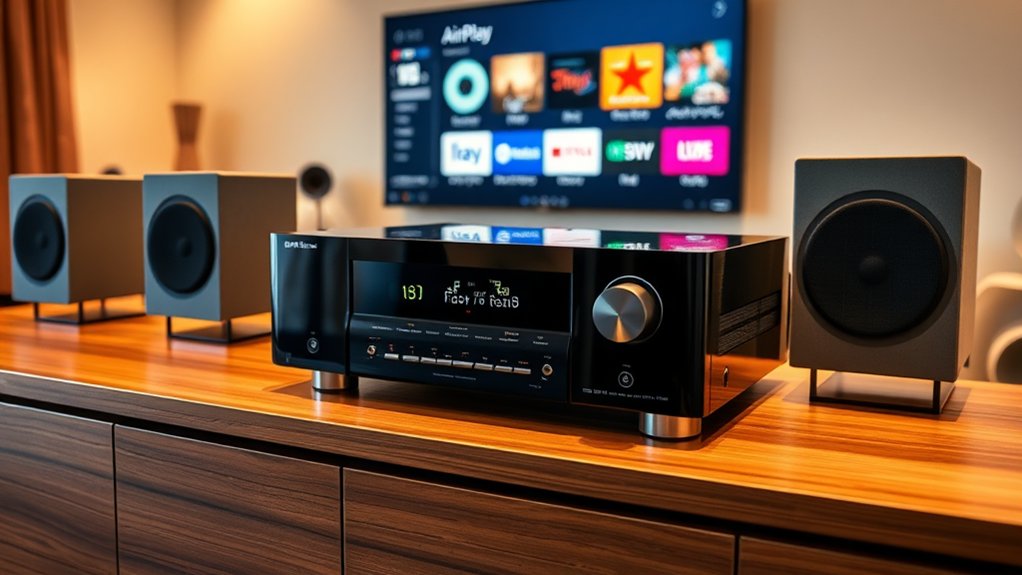When choosing an AV receiver for large rooms, start by evaluating power needs, as spaces over 250 square feet usually require over 100 watts per channel for good sound. A 7.1-channel setup improves immersion, as quality speakers guarantee peak audio. Don’t forget ample HDMI inputs for all your devices, and consider features like Dolby Atmos for that cinema-like experience. It’s essential to think about your budget too—after all, who doesn’t love a great deal? Keep going to reveal more helpful tips!
Key Highlights
- Opt for a 7.1 receiver for larger rooms over 400 square feet to ensure optimal sound distribution and immersion.
- Choose a receiver with at least 100 watts per channel for rooms over 250 square feet to achieve adequate sound pressure levels.
- Ensure the receiver supports HDMI 2.1 for compatibility with modern 4K/120Hz and 8K devices, along with multiple inputs for various sources.
- Incorporate Dolby Atmos and other advanced audio formats for a more immersive audio experience in larger spaces.
- Utilize auto-calibration features to optimize speaker settings according to your room’s specific acoustics for improved sound quality.
Understanding Room Size and Power Needs
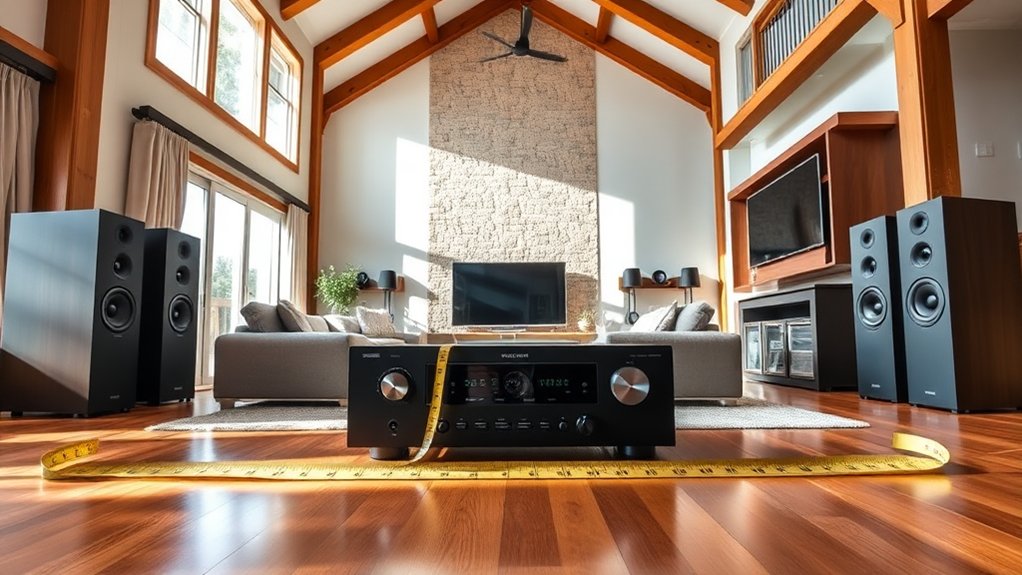
When you’re setting up an audio-visual system in a large room, understanding how room size affects your power needs is vital.
Larger spaces—especially those over 400 square feet—require more power, which is essential for achieving adequate sound pressure levels (SPL). If you have high ceilings or open layouts, sound disperses swiftly, necessitating even more power to fill the space effectively. A 7.1 receiver is often recommended for larger rooms to ensure optimal sound distribution. Additionally, many modern receivers, like the Sony STR-DH790, offer advanced features such as Dolby Atmos support to enhance immersive audio experiences.
Think of it this way: as you move away from the speakers, that sound can drop about 6 dB for every doubling of distance.
Selecting the Right Number of Channels
Selecting the right number of channels for your AV receiver is crucial, especially if you want to create an immersive sound experience in a large room.
Start with a 5.1-channel setup for decent surround sound, but if your room’s size begs for more, consider stepping up to 7.1 channels for richer audio immersion. Still not enough? Go for 9.2 or more, especially if you’re eyeing Dolby Atmos setups with ceiling speakers—who doesn’t want to feel the rain indoors, right?
Additionally, ensure that your selected receiver supports advanced audio formats to fully appreciate high-quality soundtracks. Remember, each channel corresponds to a speaker, so don’t skimp on the count. Power output is an important consideration when selecting your receiver, as it ensures the channels have sufficient power to deliver quality sound. A minimum of 5 channels is recommended for a surround sound experience, so ensure your receiver matches your speaker setup and consider future expansions.
You wouldn’t buy a sports car without room to grow, would you?
Importance of Speaker Configuration
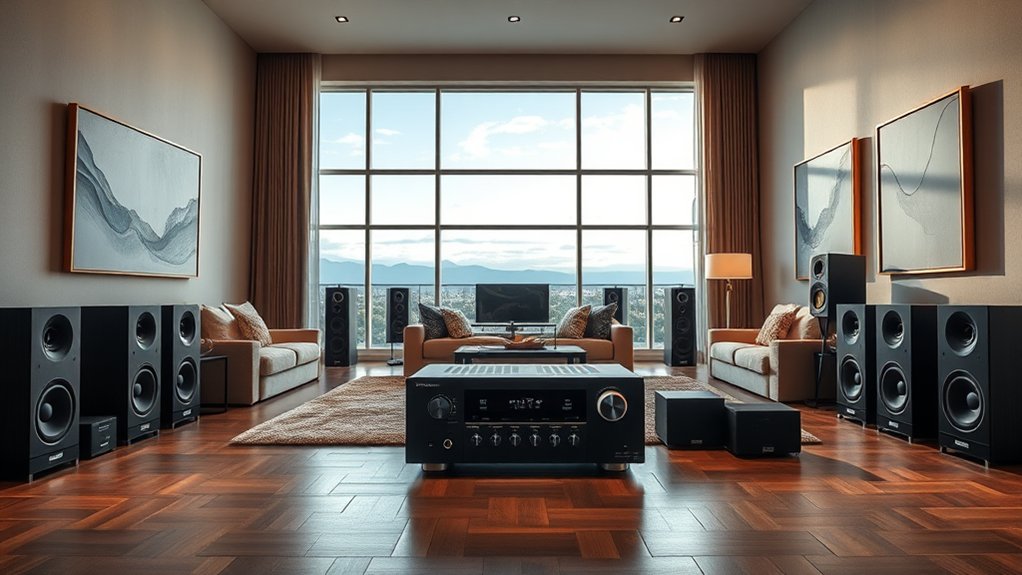
To achieve an engaging and immersive audio experience in a large room, understanding the significance of speaker configuration can’t be overstated. Properly configuring your speakers not only maximizes sound quality but additionally prevents strain on your audio system.
For instance, setting your front speakers to ‘large’ lets them play full-range audio, whereas smaller satellite or surround speakers (set to ‘small’) focus on mid and high frequencies. This manner, your subwoofer shines by handling low frequencies, striking a perfect balance. Additionally, using the correct speaker settings enhances the overall audio performance by optimizing the distribution of sound frequencies throughout the space.
Crossover settings, usually between 40Hz and 100Hz, furthermore play an essential role; lower settings may favor music, while higher ones improve movie experiences.
Optimal Speaker Size and Crossover Settings
Finding the right speaker size and setting ideal crossover frequencies is crucial, especially in a spacious environment, where sound can easily dissipate.
You’ll want to designate your front speakers as “large” if you’re not using a subwoofer; this lets them produce full-range audio. If you do have a sub, switch them to “small,” routing bass to the subwoofer for better clarity.
Now, regarding crossover settings, aim for around 80 Hz to blend the sub’s output smoothly—higher settings might make the bass sound like it’s coming from one specific spot, not from everywhere.
Experimenting with lower frequencies can improve sound for music, letting your speakers handle more mid-bass, simplifying that intricate balance between power and precision.
Connectivity: What You Need
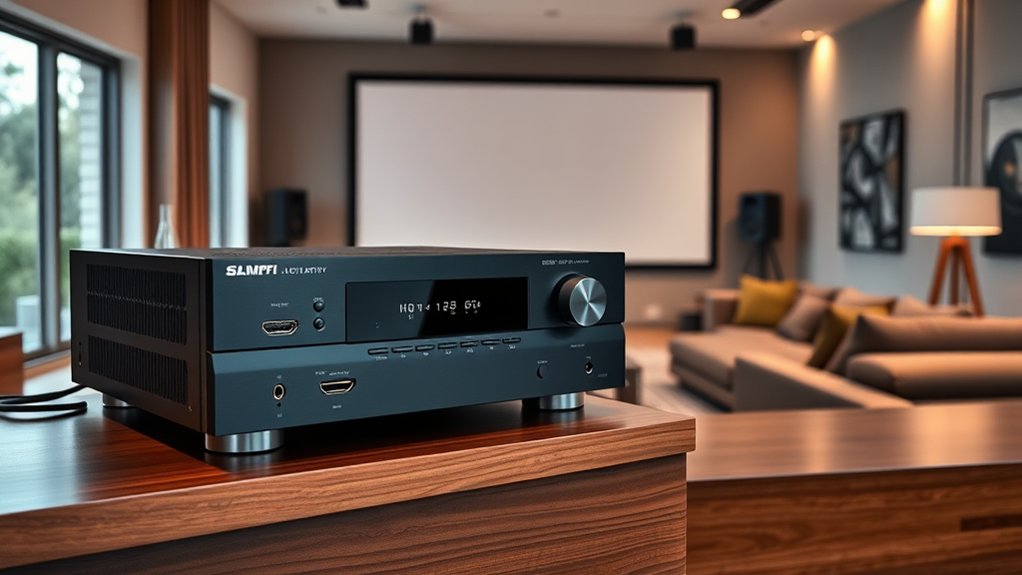
When it comes to choosing an AV receiver, connectivity really makes a difference in how you experience entertainment, especially in larger rooms where you want that immersive feel.
You’ll definitely want multiple HDMI inputs—think of them as your personal traffic control for Blu-ray players, gaming consoles, and streaming devices. Aim for HDMI 2.1 support to keep pace with 4K/120Hz and 8K content.
Moreover, built-in Wi-Fi and streaming services integration means you can ditch those annoying cables. And, if you’re feeling fancy, external wireless adapters will let you play music from anywhere in the house.
With various audio inputs and outputs, you can connect everything from your turntable to fancy subwoofers. Isn’t it nice when technology just works?
Room Acoustics and Calibration
Even though you mightn’t think about it at first, room acoustics can make or break your listening experience, especially in large spaces where sound waves bounce around like a pinball.
In these areas, problems like excessive reverberation can lead to muddled sounds, making it tough to catch every word. Standing waves too create uneven sound, so treat those walls with acoustic panels and diffusers to absorb unwanted echoes.
Don’t overlook speaker placement, either—keeping them at least a foot from walls avoids that boomy bass.
Furthermore, your AV receiver’s calibration features are vital; they adjust sound output based on room measurements, helping you achieve clear, balanced audio.
Advanced Features for Enhanced Experience
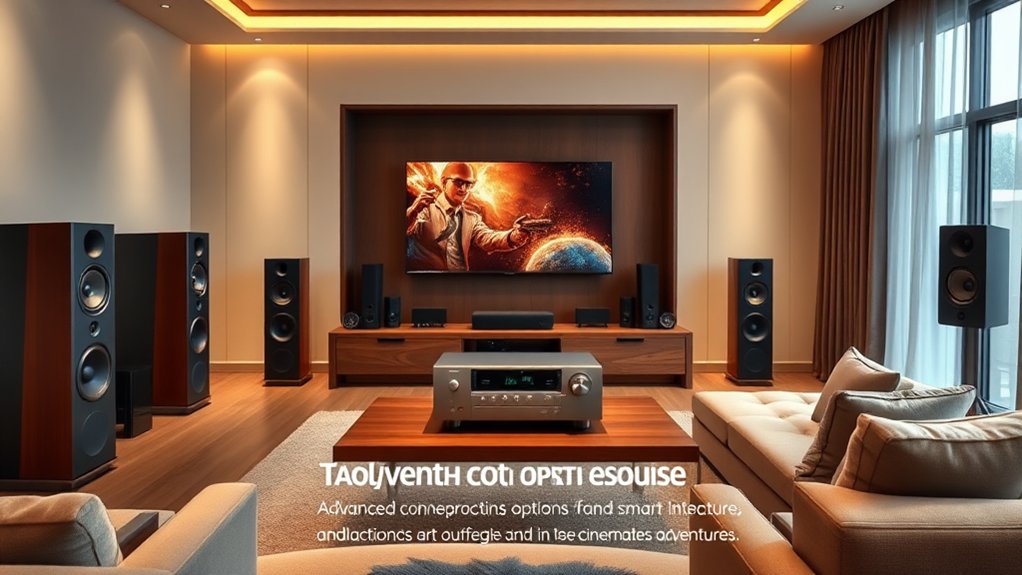
In the context of elevating your home audio experience, advanced features in AV receivers play a crucial role, especially for large rooms that crave powerful, immersive sound.
For instance, support for Dolby Atmos and DTS:X Pro takes audio beyond traditional surround sound, letting you feel the action as sounds move overhead.
Got multiple devices? HDMI 2.1 inputs make switching between your gaming console and streaming box seamless.
Plus, with multi-zone capabilities, you can enjoy different audio in each room—perfect for entertaining guests or sneaking in that movie marathon.
And let’s not forget about ample power output; you wouldn’t want your sound to be as flat as last week’s soda, would you?
These features set the stage for an audio experience like no other! Additionally, look for object-based audio rendering capabilities in your AV receiver to ensure precise sound placement and an even more immersive listening environment.
Future-Proofing Your AV Receiver
Looking to guarantee your AV receiver stands the test of time?
First, you’ll want one that supports the latest surround sound formats like Dolby Atmos and DTS:X, so you’re not left behind in the cinematic audio transformation.
Look for HDMI inputs with the latest standards, like HDMI 2.1, to ascertain it handles future 4K and 8K content effortlessly.
Make certain the receiver has enough channels—think 7.2 or 9.2—to accommodate any future speaker setups you may desire (imagine your sound experience expanding like your movie collection!).
It’s likewise wise to choose a receiver that’s firmware-upgradable; after all, who doesn’t love free upgrades?
Budget Considerations for Large Rooms
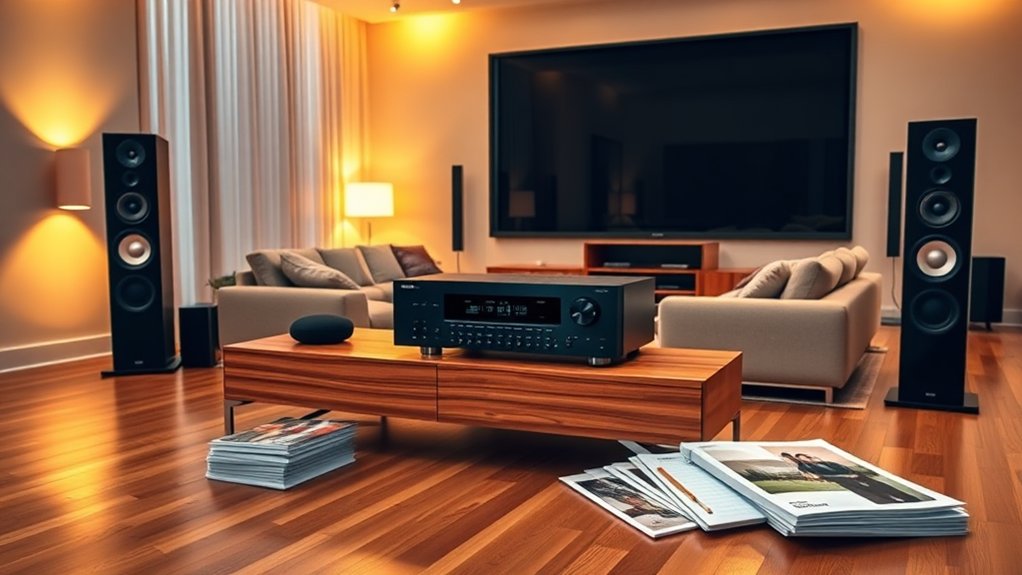
Budgeting for an AV receiver in a large room can feel like maneuvering through a maze, but it doesn’t have to be overwhelming.
Start by considering the room size; if it’s over 250 square feet, you’ll need a receiver with over 100 watts per channel for that powerful, immersive sound.
For rooms over 250 square feet, opt for a receiver with over 100 watts per channel for optimal sound.
Certainly, higher wattage and channel counts can bump up costs, but think of it as investing in your listening pleasure.
Don’t forget to factor in quality speakers and accessories, as they’re vital for filling that spacious environment. You’d hate to buy a fantastic receiver only to find out your speakers can’t keep up, right?
Research mid-range options with fundamental features to help you strike that balance between performance and budget. Additionally, considering soundbars like the Klipsch Cinema 600 can enhance the audio experience in larger setups.
Tips for System Setup and Integration
When you immerse yourself in setting up your AV receiver for a large room, it’s essential to keep in mind that every space has its quirks, which can greatly affect how sound travels and is perceived.
Start by using the included setup microphone for auto-calibration, ensuring you specify speaker types like upward-firing Dolby Atmos.
Remember to measure room dimensions accurately for ideal tuning (who wants a sound experience that’s out of sync, right?).
Pay attention to ventilation, too; avoid that cozy cabinet where overheating might occur.
Finally, as you manage your cables, think of them as unruly cats; tangles can ruin your signal and sanity.
Frequently Asked Questions
Can I Use My Existing Speakers With a New AV Receiver?
Yes, you can use your existing speakers with a new AV receiver. Just make sure the receiver matches their impedance and power handling. Check connections and settings to optimize sound quality and prevent damage.
How Do I Know if My Room Needs Acoustic Treatment?
To know if your room needs acoustic treatment, listen for echoes or muffled sounds. If conversations or music lack clarity, consider treating surfaces. Observing sound reflections and reverb can guide your treatment decisions effectively.
What Brand Offers the Best Reliability for AV Receivers?
When considering reliability for AV receivers, you can’t go wrong with Denon for solid performance and value. Sony furthermore excels in build quality, whereas Onkyo consistently offers dependable connectivity and ease of use.
How Can I Troubleshoot Sound Issues With My AV Receiver?
To troubleshoot sound issues with your AV receiver, check connections, verify devices are powered, adjust settings in the menu, and consider resetting the receiver. Keep cables in good condition for peak performance.
Are There Specific Brands to AVoid When Choosing an AV Receiver?
You should avoid brands like Denon and Marantz’s earlier models from 2020 because of HDMI 2.1 bugs. Yamaha’s older models likewise have issues. Always check for reviews on specific units before purchasing to guarantee quality.

